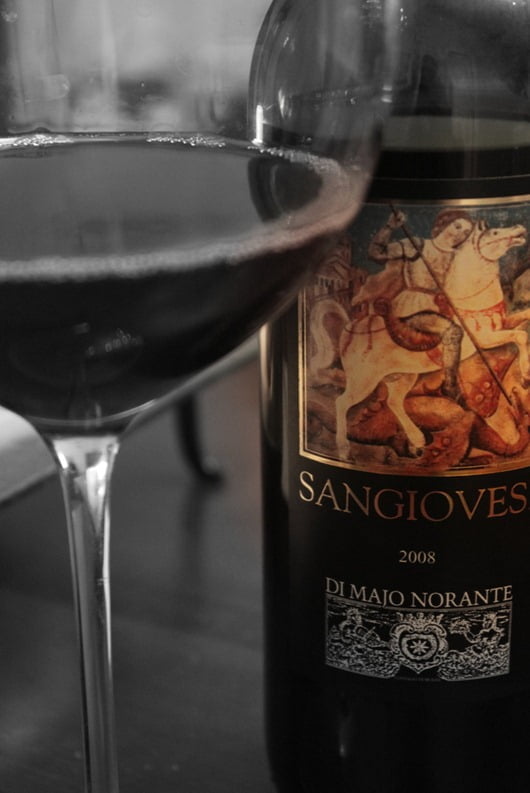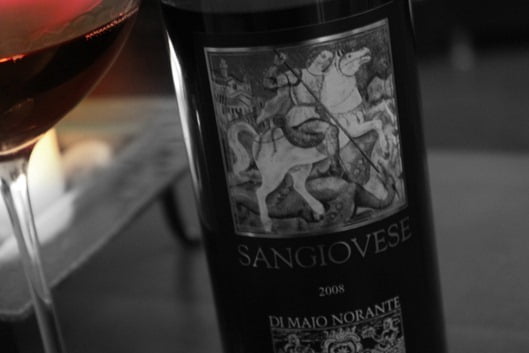Di Majo Norante Sangiovese, Umbria – Italy
June 7, 2011Grapes
100% Sangiovese [San-joe-vay-say]
The name Sangiovese is thought to come from Sanguis Jovis or “Blood of Jove” (Jove being the Roman name for Jupiter), indicating that wines were made from Sangiovese grapes even back in Roman times.
Facts
Di Majo Norante Sangiovese has been an easy-drinking Italian go-to of mine for quite some time now. Considering how many bottles I’ve popped open over the last few years, I thought a review was warranted. If you want to check out some of Di Majo’s higher end examples, their Don Luighi is a good direction to go.
The Di Majo Norante family has been growing their own grapes, and making wine since the 1800’s. They also produce 14 different wines using some of the more obscure grapes in Italy, such as Malvasia, Trebbiano, Greco, Aglianico and Bombino.
All the wines are from organically grown grapes and received accreditation in 1997, certifying the Di Majo winery as 100% organic.
Sangiovese is the most widely planted grape variety in Italy; the main problem with Sangiovese being that the general public don’t know too much about it. If you’ve ever tried a Chianti, you’ve tasted Sangiovese (and just so that everyone is on the same page, Chianti is not a grape it’s a region in Tuscany, which must contain a minimum of 80% Sangiovese to be labeled as a Chianti).
Wine made from Sangiovese tends to be pale in color and have an acidity that some people find bitter or harsh. I’ve always been of the opinion that you need food with the majority of red wines coming out of Italy (or arguably most of Europe). That’s how they were meant to be served. Ask yourself what would you pair with it to balance out the acidity, or mellow out those tannins?
 Place (click for larger view)
Place (click for larger view)
Molise is the 2nd smallest wine region in Italy and definitely one of the least well recognized. Its wines are made mainly for local consumption (going back to my main point about them using obscure grapes, and therefore being less marketable to us crazy Americans whom have no idea what Aglianico is).
Molise is also one of the more recent additions (at least by Italian standards) to Italy’s wine regions, effectively being separated from the nearby Abruzzo region in 1963.
Over recent years, young wine makers and modernization have lead to a recent rise in popularity, with Di Majo Norante being one of the key wineries responsible for this revitalization.
The warm climate, a majority of mountainous and hilly terrains, and near ideal conditions, makes Molise excellent for cultivating grapes. Also made in Molise are spirits such as Grappa, Sambuca, and numerous other liquors infused with fruit and herbs. Sounds like my kind of town!
Taste
On the nose very floral (violets). Plenty of red berries, leather, subtle oak and spice.
The typical Sangiovese sour cherry dominates the palate, with blackberry and fresh fruit flavors. Subtle vanilla, earth, leather and spice on the medium finish. The acidity doesn’t overwhelm, making it perfect if you haven’t tried a pure Sangiovese before, nice and easy-drinking and not overly complex.
Pairing
Like I always say, think like the locals! You want red sauce pastas, pizza, sausage, fresh tomatoes, dried herbs such as basil and oregano, pesto, charcuterie, and cheeses such as Parmesan and aged Gouda. But not all on the same plate…but that does sound awesome.
Price
$12.99 or thereabouts.
This entry was posted in Reviews and tagged Abruzzo, Best Italian Wine, Chianti, Di Majo Norante, Italian Wine, Italy, Molise, Organic, Sangiovese, Tuscany. Bookmark the permalink. ← Thinking of Opening a Winery in Napa? You Should Probably Read this First…Part 4 of 4 The Foursquare Wino Badge →












